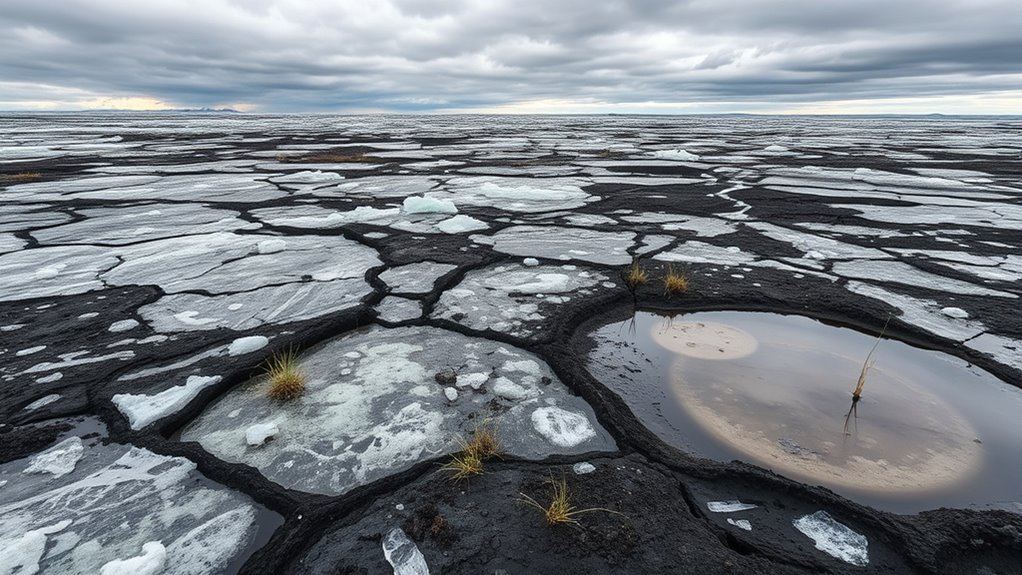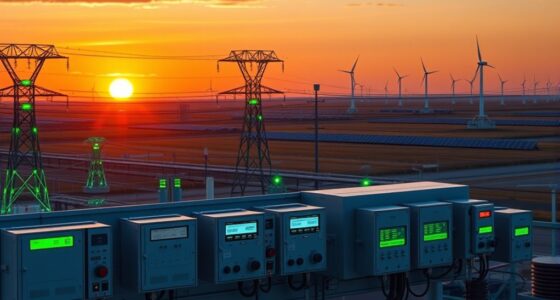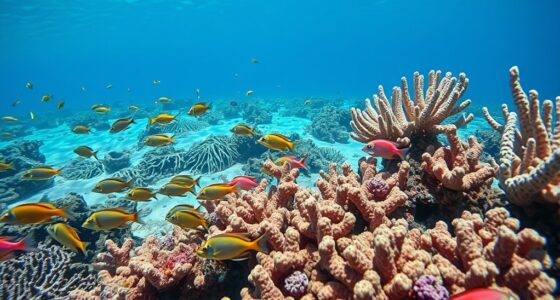Permafrost thaw presents both a manageable risk and a potential threat, depending on various factors like climate change and local conditions. If warming accelerates, large amounts of stored organic material could rapidly release methane, creating a feedback loop. However, progress in climate efforts and monitoring technologies can help control this risk. Understanding what influences these methane releases can help you grasp whether it’s a looming disaster or a challenge we can address—more details await to shed light on the specifics.
Key Takeaways
- Methane release from thawing permafrost varies, with some emissions manageable and others potentially rapid and extensive.
- Multiple factors, including warming rate and soil type, influence whether methane release becomes a significant climate feedback.
- Ongoing climate efforts and technological monitoring can help predict and mitigate large-scale methane releases.
- Immediate reduction of greenhouse gases is crucial to prevent permafrost from becoming a major methane source.
- Permafrost methane risk is complex and uncertain, but proactive measures can reduce the likelihood of a catastrophic “methane bomb.”

However, it’s essential to understand that the potential impacts aren’t entirely unpredictable or unstoppable. The release of methane from thawing permafrost is influenced by multiple factors, including the rate of warming, soil composition, and local climate conditions. Some areas might release methane gradually, allowing natural processes to absorb or oxidize some of the gas before it reaches the atmosphere. Others may experience rapid releases, especially if the permafrost contains large amounts of organic material that decompose quickly once thawed. The scale of this methane release depends on how much permafrost is affected and how fast the thaw occurs. While scientists acknowledge the risk of a climate feedback loop, they also emphasize that it’s not a foregone conclusion that methane release will spiral out of control. Much depends on global efforts to reduce greenhouse gas emissions and slow down warming trends. Understanding the mechanisms behind permafrost thaw can help inform strategies for mitigation and adaptation. They also highlight the importance of climate modeling to predict potential release scenarios more accurately. Additionally, advances in remote sensing technologies are improving our ability to monitor permafrost changes in real-time, which can aid in early warning systems. Recognizing the role of permafrost carbon stores is crucial for developing effective climate strategies. You may feel overwhelmed by the potential for catastrophic consequences, but there’s reason for cautious optimism. Researchers are actively studying these processes and developing models to predict future releases more accurately. They’re also exploring ways to mitigate risks, such as monitoring vulnerable areas and implementing strategies to slow permafrost thaw. While the threat of a methane bomb is real, it’s not inevitable. Your actions—supporting policies that curb emissions, reducing your carbon footprint, and raising awareness—can help manage this risk. In the end, understanding the interplay between permafrost thaw and climate feedback is vital. It underscores the importance of immediate, sustained efforts to limit warming and prevent the worst outcomes of this natural but potentially dangerous process.
Frequently Asked Questions
How Quickly Is Permafrost Melting Worldwide?
You might wonder how fast permafrost is melting globally. Currently, permafrost feedbacks accelerate thawing, especially in Arctic regions, with some areas experiencing thermokarst development—irregular landforms caused by ice-rich soil melting. This process varies by location, but overall, scientists observe an increasing rate of permafrost loss. Your understanding of these rapid changes highlights the urgency to monitor and mitigate potential climate impacts linked to this ongoing thaw.
Can Permafrost Thaw Be Reversed or Halted?
Imagine freezing a fragile painting to preserve its beauty—you can’t fully undo damage once it’s thawed. Similarly, permafrost thaw can’t be fully reversed, but you can employ thaw prevention strategies like reducing greenhouse emissions and protecting Arctic regions. While permafrost restoration is limited, proactive measures slow thawing, helping manage risks. Your actions now can preserve this icy treasure, preventing the release of trapped methane and safeguarding future stability.
What Regions Are Most at Risk of Rapid Thaw?
You should know that Arctic regions, especially Siberia, Alaska, and northern Canada, are most at risk of rapid thaw. These areas contain vulnerable Arctic ecosystems and infrastructure that could be seriously affected. As permafrost melts quickly, it threatens ecosystems and damages roads, pipelines, and buildings. Staying aware of these risks helps you understand the urgency of monitoring thaw patterns and implementing strategies to protect both the environment and human infrastructure.
How Accurate Are Current Methane Emission Predictions?
You might wonder how accurate current methane emission predictions are. While models provide valuable insights, they still face significant uncertainty due to complex climate interactions and limited data. This model uncertainty means predictions can vary, making it challenging to precisely estimate future methane releases. Despite improvements, prediction accuracy remains a work in progress, highlighting the need for ongoing research to better understand and manage potential climate impacts.
What Are the Economic Impacts of Permafrost Thaw?
You’ll find that permafrost economics reveal significant thawing costs, impacting local and global economies. As permafrost melts, infrastructure damages, disrupted ecosystems, and increased greenhouse gases lead to costly repairs and adaptation efforts. You may face rising insurance premiums and economic instability in Arctic regions. Managing these thawing costs requires proactive policies, but without action, the economic impacts could escalate, making it essential for you to understand and address these risks now.
Conclusion
So, next time you hear about permafrost thaw releasing methane, just imagine hosting a surprise gas party in the Arctic—complete with global warming confetti. Sure, it’s a ticking time bomb, or maybe just a really dramatic firework show you can’t control. Either way, you might as well sit back, relax, and enjoy the spectacle. After all, what’s a little methane when we’ve got so many other things to worry about?










